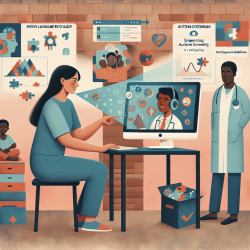Empowering Practitioners: Enhancing Autism Screening in Low- and Middle-Income Countries

The early identification of Autism Spectrum Disorders (ASD) is critical for initiating timely interventions that can significantly improve developmental outcomes for children. However, practitioners in low- and middle-income countries (LMIC) often face unique challenges, including a lack of culturally appropriate screening tools. A recent study titled "Screening Children for Autism Spectrum Disorders in Low- and Middle-Income Countries: Experiences from the Kurdistan Region of Iraq" offers valuable insights into overcoming these obstacles.The study focused on developing and validating a screening tool based on the Gilliam Autism Rating Scale-3 (GARS-3), originally developed in the USA. By tailoring this tool to the Kurdish cultural context, researchers were able to create a more effective method for identifying children at risk of ASD. Here are some key takeaways that can help practitioners improve their screening processes:
- Cultural Adaptation: The GARS-3 was translated into Kurdish and pilot-tested with local families. This step ensured that the tool was linguistically and culturally appropriate, making it easier for parents to understand and accurately complete.
- Training and Consistency: Practitioners underwent extensive training to ensure consistent administration of the tool. This included workshops on ASD symptoms, DSM-5 criteria, and the use of GARS-3. Video recordings of interviews were reviewed to maintain high standards.
- Item Selection: The study identified the top 10 items from the GARS-3 that best discriminated between children with ASD, developmental disabilities, and typically developing children. These items focused on social interaction, social communication, and repetitive behaviors.
- Reliability and Validity: The 10-item screening tool demonstrated high internal reliability (Cronbach’s alpha = 0.881) and strong correlations with the full GARS-3 scale. It effectively distinguished children with ASD from typically developing children with a high degree of accuracy.
- Challenges and Limitations: The tool was less effective in differentiating ASD from other developmental disabilities, highlighting the need for comprehensive assessments. Additionally, the study's retrospective design suggests the need for prospective studies to validate the tool further.
To implement these findings, practitioners can start by adapting existing screening tools to their cultural contexts, ensuring linguistic clarity and cultural relevance. Training is essential for maintaining consistency and accuracy in administering these tools. Finally, screening should be part of a broader system that includes follow-up assessments and interventions.By taking these steps, practitioners can improve early identification of ASD, enabling timely interventions that can make a significant difference in the lives of children and their families.To read the original research paper, please follow this link:
Screening Children for Autism Spectrum Disorders in Low- and Middle-Income Countries: Experiences from the Kurdistan Region of Iraq.
Citation: Samadi, S. A., McConkey, R., Nuri, H., Abdullah, A., Ahmad, L., & Abdalla, B. (2022). Screening Children for Autism Spectrum Disorders in Low- and Middle-Income Countries: Experiences from the Kurdistan Region of Iraq. International Journal of Environmental Research and Public Health, 19(8), 4581. https://doi.org/10.3390/ijerph19084581










